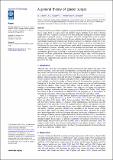A general theory of glacier surges
Abstract
We present the first general theory of glacier surging that includes both temperate and polythermal glacier surges, based on coupled mass and enthalpy budgets. Enthalpy (in the form of thermal energy and water) is gained at the glacier bed from geothermal heating plus frictional heating (expenditure of potential energy) as a consequence of ice flow. Enthalpy losses occur by conduction and loss of meltwater from the system. Because enthalpy directly impacts flow speeds, mass and enthalpy budgets must simultaneously balance if a glacier is to maintain a steady flow. If not, glaciers undergo out-of-phase mass and enthalpy cycles, manifest as quiescent and surge phases. We illustrate the theory using a lumped element model, which parameterizes key thermodynamic and hydrological processes, including surface-to-bed drainage and distributed and channelized drainage systems. Model output exhibits many of the observed characteristics of polythermal and temperate glacier surges, including the association of surging behaviour with particular combinations of climate (precipitation, temperature), geometry (length, slope) and bed properties (hydraulic conductivity). Enthalpy balance theory explains a broad spectrum of observed surging behaviour in a single framework, and offers an answer to the wider question of why the majority of glaciers do not surge.
Citation
Benn , D I , Fowler , A , Hewitt , I & Sevestre , H 2019 , ' A general theory of glacier surges ' , Journal of Glaciology , vol. 65 , no. 253 , pp. 701-716 . https://doi.org/10.1017/jog.2019.62
Publication
Journal of Glaciology
Status
Peer reviewed
ISSN
0022-1430Type
Journal article
Description
Acknowledgements. Funding for DIB was provided by NE/R018243/1 REBUS (Resolving Enthalpy Budget to Understand Surging).Collections
Items in the St Andrews Research Repository are protected by copyright, with all rights reserved, unless otherwise indicated.

